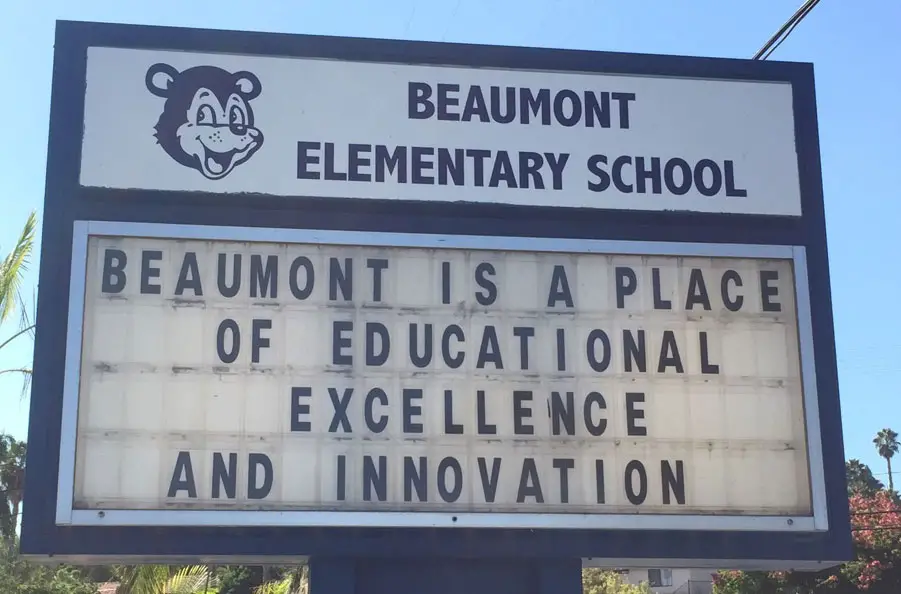VISTA — Parents of Beaumont Elementary School students showed up for Vista Unified School District’s first workshop in its bond reprioritization process to express frustration with the school district’s decision to suspend a first-phase project at the school.
In a special VUSD board meeting last week, district officials began breaking down the needs and priorities of its Measure LL Facilities Bond.
“Recently, like every school district, we have experienced dramatic cost associated with building,” Superintendent Matt Doyle said. “As a result of that, we need to revisit the list of projects and have conversations with the board about what we can fiscally accomplish given the fact that there is significant cost escalation.”
Prior to the Wednesday, March 23, meeting, the board had already begun reconsidering its project list. One such move impacted the $17.2 million project to replace the portable classrooms at Beaumont Elementary School.
Although knowing there would be backlash from the community, the board voted in February to pause the project citing multiple complexities with the site’s facilities and scope of the project.
This decision, followed by other bond project amendments, helped lead the board to reconsider its facilities bond entirely.
During the first of three hearings, four parents of students at Beaumont Elementary spoke out against the pause and called on the board to show up for their children.
“I don’t even know why we are saying pause,” said parent Adriana Diaz. “It’s not okay that we’re telling our children that that is the kind of school you go to because of your socioeconomic status. We’re not telling them. They know it, they see it.”
Beaumont Elementary School, built in 1959, has an enrollment of 514 with 87% categorized as “socioeconomically disadvantaged,” according to the state Department of Education’s California School Dashboard.
The parents argued that stopping work at Beaumont during the first phase goes directly against the VUSD board’s goal to provide equitable access to education and innovation.
“We are a school of underprivileged and overlooked children,” said Amanda Remmen, a member of the PTA with four children who have attended the school at one point. “Beaumont is their safe space and yet our facilities are not a safe space.”
Measure LL, passed in 2018, authorizes the district to issue and sell $247 million in general obligation bonds at a rate of about $33.15 per $100,000 of assessed property value. The bond is a series of construction and facilities maintenance projects with a long-term scope into 2035.
The district has had successes over the first couple of years of the bond — completing projects at 12 schools — despite a few bumps. Doyle said, for example, that renovations to Bobier Elementary School at one point were paused and have since restarted. Bobier Elementary was built in 1956 and has an enrollment of 570, with more than 96% labeled “socioeconomically disadvantaged.”
However, there are several reasons to reassess bond projects. Funds are tightening up, even though the most recent projects were generally completed at or under budget.
The district is finding the cost of construction and supplies have increased between 20% and 30% in some cases, Doyle said.
Also, the initial bond valuation was based on a collection of wants and needs reported by employees of the schools.
“Those original estimates were done by folks that were not architects or contractors,” said Doyle, who was not superintendent at the time. “So, they were true estimates.”
Now, the board is taking a step back to “be thoughtful” about the challenges facing the district.
“We care deeply about Beaumont,” Doyle said. “We are absolutely committed to Beaumont and all of our schools, but sometimes we have to make adjustments.”
Doyle added that on April 4 a team of architects is scheduled to visit the elementary school to gather additional information.
Directly after public comment, the board went to work reassessing the project list. With 53 flashcards — representing the listed items — the board was faced with the categories it created for itself in the beginning stages of the bond.
The flashcards described the project but left off the name of the school that would receive the work, a way to hone in on which categories of projects the board found most important.
The goal of the bond is “to repair, upgrade, equip classrooms, science labs, local school facilities supporting college readiness, career preparation, math, science, engineering, technology, skilled trades; repair aging classrooms/schools including deteriorating roofs, plumbing, and electrical; improve student safety/school security,” as stated in the bond language.
The school board has flexibility in naming, removing and altering projects, so long as the changes stay within “the spirit of the bond,” according to Doyle.
“I am hearing things tonight from speakers that … I didn’t hear about then, and they probably didn’t exist that many years ago,” said board member Rosemary Smithfield, “but things get worse and worse and worse and now it’s a problem.”
Smithfield questioned whether the project list reflected the true needs of the district, which is something the board intends to investigate as it moves forward in the reprioritization process.
In its three-hour meeting last week, members found that projects were mainly related to three of the six categories listed in the facilities bond improvement plan: Categories C, D and E.
Category C includes safety and security improvement projects; Category D, projects to modernize or improve building systems and infrastructure; and Category E, projects to meet academic and safety standards.
The next bond workshop is on April 21 at 5 p.m. and will focus on the bond’s financial status and funding sources, as well as members’ finalizing the prioritized needs and categories. The final workshop is May 11.


